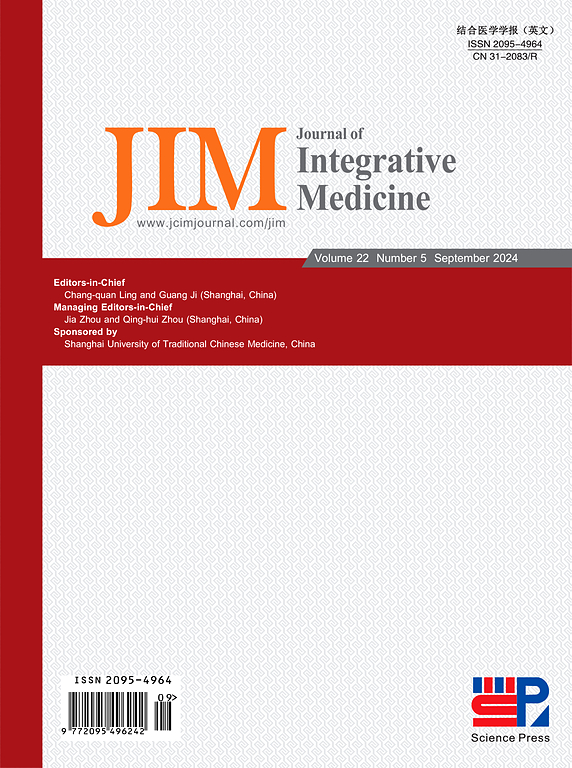针刺足三里及其组合穴治疗应激性胃溃疡的机制——基于脏腑与穴位相关性的研究。
IF 4
2区 医学
Q1 INTEGRATIVE & COMPLEMENTARY MEDICINE
引用次数: 0
摘要
胃溃疡是一种常见的消化系统疾病。针刺作为中医外治法之一,在治疗GU中具有多靶点、多途径、多层次作用的特点。经穴与脏腑的关系是中医理论的重要组成部分,对疾病的诊断和治疗至关重要。腧穴与脏腑之间存在着内外联系。脏腑的病理反应可以表现为穴位致敏,而穴位的刺激可以在脏腑内部起到治疗作用。因此,穴位具有反映和治疗疾病的功能。本文就GU患者体表压痛点及取穴规律进行探讨。此外,选择足三里(ST36)作为胃经中最常用的穴位之一,更详细地展示了穴位刺激治疗GU的机制,特别是在已经得到充分研究的应激性GU (SGU)模型中。因此,本文将进一步探讨针刺ST36及常用穴位联合治疗SGU的机制。治疗效果可通过抗炎和抗氧化活性、胃粘膜损伤修复以及与脑肠轴的相互作用来实现。综上所述,本综述为全面了解GU的腧穴功能现象和机制提供了依据。何敏,林学勇,李军,李玲,张涛。基于脏腑与穴位相关性的针刺足三里及其组合穴治疗应激性胃溃疡的机制。集成医学[J];打印前Epub。本文章由计算机程序翻译,如有差异,请以英文原文为准。
Mechanisms of acupuncture at Zusanli (ST36) and its combinational acupoints for stress gastric ulcer based on the correlation between Zang-fu and acupoints
Gastric ulcer (GU) is a common digestive system disease. Acupuncture, as one of the external treatments of traditional Chinese medicine (TCM), has the characteristics of multi-target, multi-pathway and multi-level action in the treatment of GU. The relationship between meridian points and Zang-fu is an important part of the theory of TCM, which is crucial for the diagnosis and treatment of diseases. There is an external and internal link between acupoints and Zang-fu. The pathological reaction of Zang-fu can manifest as acupoint sensitization, while stimulation of acupoints can play a therapeutic role in the internal Zang-fu. Therefore, the acupoint has the functions of reflecting and treating diseases. This review explores the tender points on the body surface of patients with GU and the rules of acupoint selection. In addition, Zusanli (ST36), as one of the most used acupoints of the stomach meridian, was selected to show the mechanisms behind acupoint stimulation in the treatment of GU in greater detail, specifically in the well-studied model of the stress GU (SGU). Hence, the mechanisms of acupuncture at ST36 and points commonly used in combination with ST36 to treat SGU are discussed further. Treatment effects can be achieved through anti-inflammatory and antioxidant activities, gastric mucosal injury repair, and interaction with the brain-gut axis. In summary, this review provides evidence for a comprehensive understanding of the phenomena and mechanism of acupoint functions for GU.
Please cite this article as: He M, Lim XY, Li J, Li L, Zhang T. Mechanisms of acupuncture at Zusanli (ST36) and its combinational acupoints for stress gastric ulcer based on the correlation between Zang-fu and acupoints. J Integr Med. 2025; 23(1): 1–11.
求助全文
通过发布文献求助,成功后即可免费获取论文全文。
去求助
来源期刊

Journal of Integrative Medicine-Jim
Medicine-Complementary and Alternative Medicine
CiteScore
9.20
自引率
4.20%
发文量
3319
期刊介绍:
The predecessor of JIM is the Journal of Chinese Integrative Medicine (Zhong Xi Yi Jie He Xue Bao). With this new, English-language publication, we are committed to make JIM an international platform for publishing high-quality papers on complementary and alternative medicine (CAM) and an open forum in which the different professions and international scholarly communities can exchange views, share research and their clinical experience, discuss CAM education, and confer about issues and problems in our various disciplines and in CAM as a whole in order to promote integrative medicine.
JIM is indexed/abstracted in: MEDLINE/PubMed, ScienceDirect, Emerging Sources Citation Index (ESCI), Scopus, Embase, Chemical Abstracts (CA), CAB Abstracts, EBSCO, WPRIM, JST China, Chinese Science Citation Database (CSCD), and China National Knowledge Infrastructure (CNKI).
JIM Editorial Office uses ThomsonReuters ScholarOne Manuscripts as submitting and review system (submission link: http://mc03.manuscriptcentral.com/jcim-en).
JIM is published bimonthly. Manuscripts submitted to JIM should be written in English. Article types include but are not limited to randomized controlled and pragmatic trials, translational and patient-centered effectiveness outcome studies, case series and reports, clinical trial protocols, preclinical and basic science studies, systematic reviews and meta-analyses, papers on methodology and CAM history or education, conference proceedings, editorials, commentaries, short communications, book reviews, and letters to the editor.
Our purpose is to publish a prestigious international journal for studies in integrative medicine. To achieve this aim, we seek to publish high-quality papers on any aspects of integrative medicine, such as acupuncture and traditional Chinese medicine, Ayurveda medicine, herbal medicine, homeopathy, nutrition, chiropractic, mind-body medicine, taichi, qigong, meditation, and any other modalities of CAM; our commitment to international scope ensures that research and progress from all regions of the world are widely covered. These ensure that articles published in JIM have the maximum exposure to the international scholarly community.
JIM can help its authors let their papers reach the widest possible range of readers, and let all those who share an interest in their research field be concerned with their study.
 求助内容:
求助内容: 应助结果提醒方式:
应助结果提醒方式:


